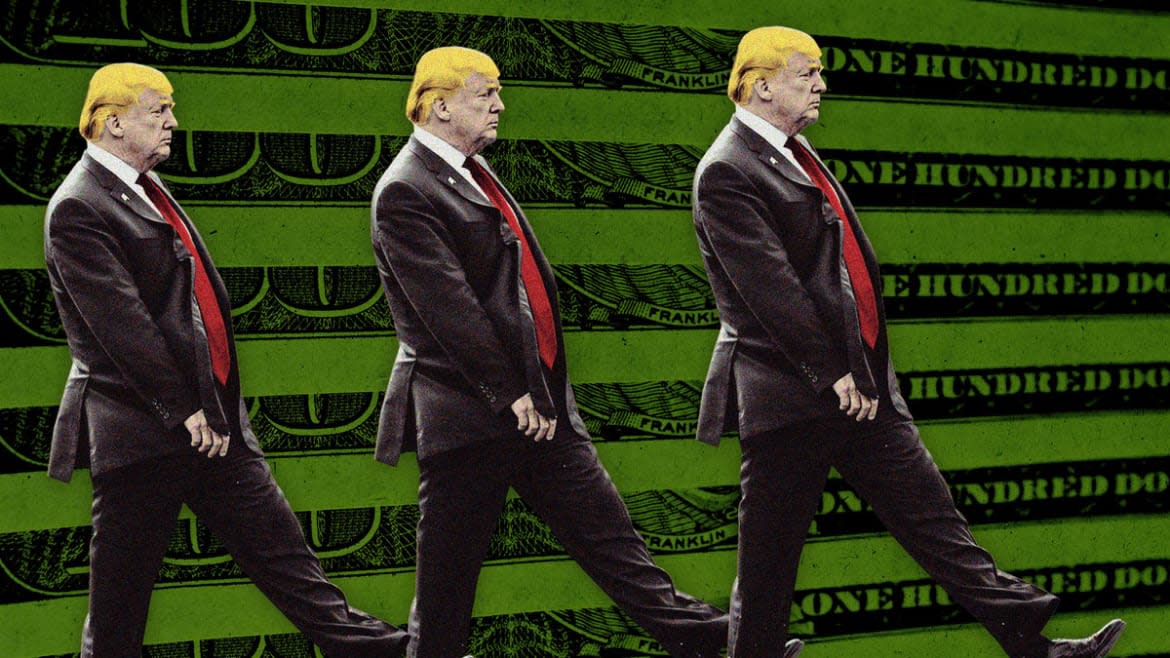These Trump Campaign Payments to the Trump Organization Look Shady as Hell

The Trump campaign’s payments to the Trump Organization for a week-long “donor retreat” at Mar-a -Lago earlier this year look awfully similar to money laundering.
Investigative reporter David Fahrenthold tweeted out the receipts earlier this week, showing $380,000 in payments over two days, broken into chunks of $10,000 and less—which happens to be the reporting requirement for receipt of cash payments in a trade or business to FinCEN (the Financial Crimes Enforcement Network)—that he described as “Campaign donations turned into private revenue for POTUS.”
The Trump Organization’s record of the payment raises many questions I’m familiar with from my 30-year career as an investigator at the IRS: Is the $380,000 income? If so, what was delivered in exchange for it? Were these payments for past services rendered or for future expected returns? Who were the donors? Why didn’t the Trump Organization just report the entire $380,000 in total? Why break that down into separate transactions? Why was each payment identically described as “Facility Rental/ Catering Services”? Is something being disguised here?
Could the above financial transactions be legitimate? Perhaps. The Trump campaign and the Trump Organization did not immediately respond to questions on Thursday; the Trump Organization has said that “the figure had to be broken into 43 separate payments because Mar-a-Lago can’t handle credit card transactions of more than $10,000.” Ten thousand dollars also happens to be the amount below which no reports are required to be filed.
If the Trump Organization filed a Form 8300: Report of Cash Payments Over $10,000 Received in a Trade or Business with IRS/FinCEN, then it saved itself some angst. They had 15 days after receipt of the last payment, which according to Fahrenthold’s document was made on April 1, 2020, to do so.
Donald Trump Is Paying Himself to Run for President
There are criminal penalties for structuring, or breaking a bigger payment into small chunks to evade reporting requirements, including a statutory maximum prison sentence of up to five years and/or a monetary fine of up to $250,000. But that is just the Bank Secrecy Act(BSA) violation. If structured transactions are sourced from a Specified Unlawful Activity (that is, a bribe), then Money Laundering Statute T18-1956 can be tapped, which brings a 20-year statutory maximum prison sentence into play with substantially higher monetary fines.
But it is the appearance of structuring here that sticks out. To prove that a defendant has engaged in structuring, you must prove that the defendant knew of the relevant reporting requirement. The government does not have to prove that the defendant knew structuring is illegal. It is sufficient to prove intent to evade the reporting requirement. A jury may infer a defendant’s knowledge of the reporting requirement and intent to evade it from the pattern of his transactions—which brings us back to the 43 separate transactions over two days.
Prior conduct can also weigh in a substantive fashion. FinCEN imposed a $10 million civil penalty against the Trump Taj Mahal Casino Resort on March 6, 2015, for willful and repeated violations of the BSA. The Taj has a history of prior, repeated BSA violations cited by examiners dating back to 2003. Additionally, in 1998, FinCEN assessed a $477,700 civil money penalty against the Taj for currency transaction reporting violations.
Donald Trump was in charge of the Trump Organization and the Trump casinos back in the day when FinCEN asserted the penalties referenced above. Allen Weisselberg, the current CFO of the Trump Organization and one of its trustees, has been with the Trump Organization for over 30 years. So too, Donald Trump was the chief executive officer of the Trump Organization as well as the principal of the Trump campaign at the time of the above purported Mar-a-Lago Structuring violations pertaining to the suspicious financial transactions occurring between the two Trump entities.
Given what look like possible acts of concealment in breaking down the transfer of funds from the donors on to the Trump Organization, combined with the suspicious way the Trump Organization appears to be accounting for this revenue transfer, as well as its shady history of financial transactions, it is fair to ask if the U.S. Attorney in Ft Lauderdale would be interested in opening up a BSA/money laundering investigation into these latest suspiciously structured transactions, and to see whether or not it circumvented their responsibility to file the requisite Forms 8300 with IRS/FinCEN. Another question: Did the banks servicing the Trump Organization file the requisite Currency Transaction Reports or a Suspicious Activity Report with regard to the apparent structured transactions?
More: Who are the donors who attended this so-called “donor retreat?” Are there FEC campaign contribution violations involved here? Did the Trump Campaign launder campaign contributions into revenue for the Trump Organization and turn the election campaign into just another seamy Trump revenue stream shielded from the prying eyes of responsible government agencies?
Something smells in Mar-a-Lago, and there certainly exists enough smoke here to justify a thorough search for the fire. Does the will exist at the Department of Treasury or the Department of Justice to follow the money, and the smoke, and perhaps finally put the fire out once and for all?
Get our top stories in your inbox every day. Sign up now!
Daily Beast Membership: Beast Inside goes deeper on the stories that matter to you. Learn more.

